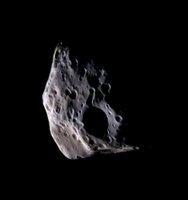 | Target Name: Epimetheus, Is a satellite of: Saturn, Mission: Cassini, Spacecraft: Cassini Orbiter, Instrument: Imaging Science Subsystem - Narrow Angle, Product Size: 701 samples x 747 lines, Produced By: CICLOPS/Space Science Institute. Primary Data Set: Cassini, Full-Res JPEG: PIA06226.jpg (22.74 kB). |
The color of Epimetheus in this view appears to vary in a non-uniform way across the different facets of the moon's irregular surface. Usually, color differences among planetary terrains identify regional variations in the chemical composition of surface materials. However, surface color variations can also be caused by wavelength-dependent differences in the way a particular material reflects light at different lighting angles. The color variation in this false-color view suggests such "photometric effects" because the surface appears to have a more bluish cast in areas where sunlight strikes the surface at greater angles.
This false color view combines images obtained using filters sensitive to ultraviolet, polarized green and infrared light. The images were taken at a Sun-Epimetheus-spacecraft, or phase, angle of 115 degrees, thus part of the moon is in shadow to the right. This view shows an area seen only very obliquely by NASA's Voyager spacecraft. The scene has been rotated so that north on Epimetheus is up.
The slightly reddish feature in the lower left is a crater named Pollux. The large crater just below center is Hilairea, which has a diameter of about 33 kilometers (21 miles).
At 116 kilometers (72 miles) across, Epimetheus is slightly smaller than its companion moon, Janus (181 kilometers, or 113 miles across), which orbits at essentially the same distance from Saturn.
The images for this color composite were obtained with the Cassini spacecraft narrow-angle camera on March 30, 2005, at a distance of approximately 74,600 kilometers (46,350 miles) from Epimetheus. Resolution in the original images was about 450 meters (1,480 feet) per pixel. This view has been magnified by a factor of two to aid visibility.
The Cassini-Huygens mission is a cooperative project of NASA, the European Space Agency and the Italian Space Agency. The Jet Propulsion Laboratory, a division of the California Institute of Technology in Pasadena, manages the mission for NASA's Science Mission Directorate, Washington, D.C. The Cassini orbiter and its two onboard cameras were designed, developed and assembled at JPL. The imaging team is based at the Space Science Institute, Boulder, Colo.
For more information about the Cassini-Huygens mission visit saturn.jpl.nasa.gov. For additional images visit the Cassini imaging team homepage ciclops.org.
Image Credit: NASA/JPL/Space Science Institute
NASA images generally are not copyrighted. Unless otherwise noted, images and video on JPL public web sites (public sites ending with a jpl.nasa.gov address) may be used for any purpose without prior permission. The endorsement of any product or service by Caltech, JPL or NASA must not be claimed or implied.
Leave a comment, make a request, Let this small sampling be a guide to better quality, more plentiful, public domain, royalty free, copyright free, high resolution, images, stock photos, jpeg, jpg, free for commercial use, clip art, clipart, clip-art. more at Public Domain Clip Art and clip art or public domain and Space or NASA and Jet Propulsion Laboratory or Saturn and Cassini-Huygens or Epimetheus













No comments:
Post a Comment